MLB Power Rankings: The Breakouts and Busts Are Shaking Things Up
We’re officially over a month into the MLB season. Season-long trends are beginning to take shape, and some of the statistical outliers are starting to stick out like sore thumbs.
In this week’s power rankings, we’re highlighting each team’s most surprising individual performance—good, bad or ugly. Off we go.
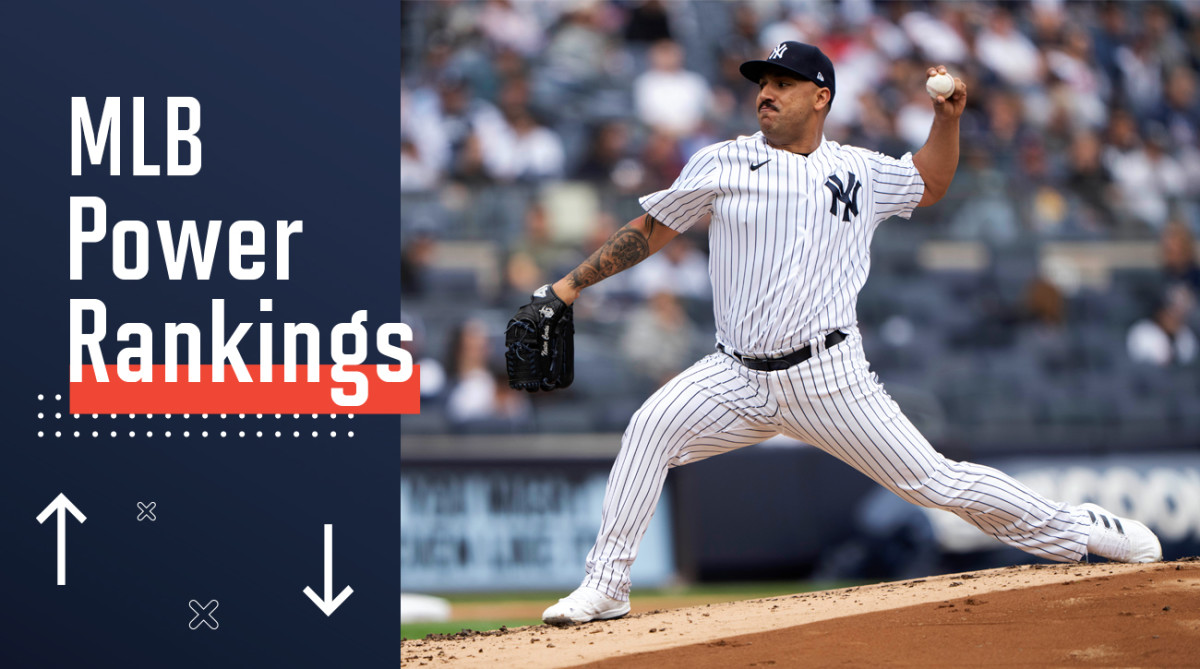
30. Cincinnati Reds (LW: 30)
Joey Votto’s ranking dead last in batting average (.122) and slugging percentage (.135) while grading out as the majors’ least valuable first baseman (-1.1 fWAR) after receiving NL MVP votes last year has been emblematic of Cincinnati’s worst start in franchise history. At least the Reds finally won a series this weekend (against the Pirates, but still, it’s something).
LAWS: Panic Meter: How Concerned to Be About These Five Sluggish Starts
29. Washington Nationals (LW: 29)
Yadiel Hernández defected from Cuba in 2015 at age 28, signed with the Nationals the following year and didn’t debut in the bigs until September 2020. Now 34, he’s batting .365, trailing only Manny Machado among players with at least 70 plate appearances. He’s also 14-for-29 with a homer and four doubles during his seven-game hitting streak.
28. Pittsburgh Pirates (LW: 26)
José Quintana’s days as a starter looked to be over after the soft-tossing lefty posted an 8.23 ERA in 10 starts for the Angels last year before he was moved to the bullpen for the Halos and Giants. But the 33-year-old has been given another shot in Pittsburgh’s rotation and is on pace to record an ERA under 4.00 for the first time since 2016.
27. Detroit Tigers (LW: 25)
The Tigers are scoring less than three runs per game. Entering the week, they have 10 hitters with at least 50 plate appearances; none of them have an OPS above .750. Austin Meadows is still looking for his first home run with Detroit after averaging 30 homers in his two full seasons with Tampa Bay. But the biggest disappointment probably has been Jonathan Schoop, who was one of the league’s more underrated veterans for a few years but now ranks last in on-base percentage (.176) amid a career-low 1.3% barrel rate.
26. Kansas City Royals (LW: 27)
Two-time MLB hits leader Whit Merrifield is sporting an MLB-worst .353 OPS and has just three extra-base hits (all doubles) in 109 plate appearances after leading the majors with 42 doubles last year in his second All-Star campaign. He also has just three stolen bases after swiping an AL-best 40 bags last year, but that’s mainly because you can’t steal many bases if you’re rarely on base.
25. Baltimore Orioles (LW: 28)
Mount Olive College graduate Bruce Zimmermann, 27, has nearly halved his ERA this season from the 5.04 mark he posted as a rookie in 2021. The lefty, who was acquired by the Orioles from the Braves in 2018 as part of a package for Kevin Gausman and Darren O’Day, doesn’t light up the radar gun but ranks in the 84th percentile of chase rate—and has good enough stuff to whiff Shohei Ohtani, Mike Trout and Anthony Rendon in order.
Bruce Zimmermann, K'ing the Side. pic.twitter.com/8SE0p4xZPG
— Rob Friedman (@PitchingNinja) April 23, 2022
24. Oakland A’s (LW: 21)
Other than Paul Blackburn, whom I highlighted in this space two weeks ago, there haven’t been any overwhelming surprises when it comes to the A’s, who are on a nine-game losing streak. So let’s give some recognition to former top catching prospect (and part-time reliever with the Padres) Christian Bethancourt for making it back to the bigs in Oakland, primarily as a first baseman after four seasons out of the majors. He never hit enough as a catcher, so I’m not sure how long this experiment will last, but he’s proving to be versatile if nothing else.
23. Chicago Cubs (LW: 22)
Nick Madrigal was hailed as one of the few great contact hitters left in the sport after batting above .300 in each of his first two seasons, but his strikeout rate (16.3%) has more than doubled since last season and his batting average is all the way down to .213.
22. Boston Red Sox (LW: 18)
Not much has gone right for Boston so far, but seemingly fixing Michael Wacha (1.38 ERA), at least temporarily, after the Rays, Mets and Cardinals all failed to do so over the last three years has to count as a win.
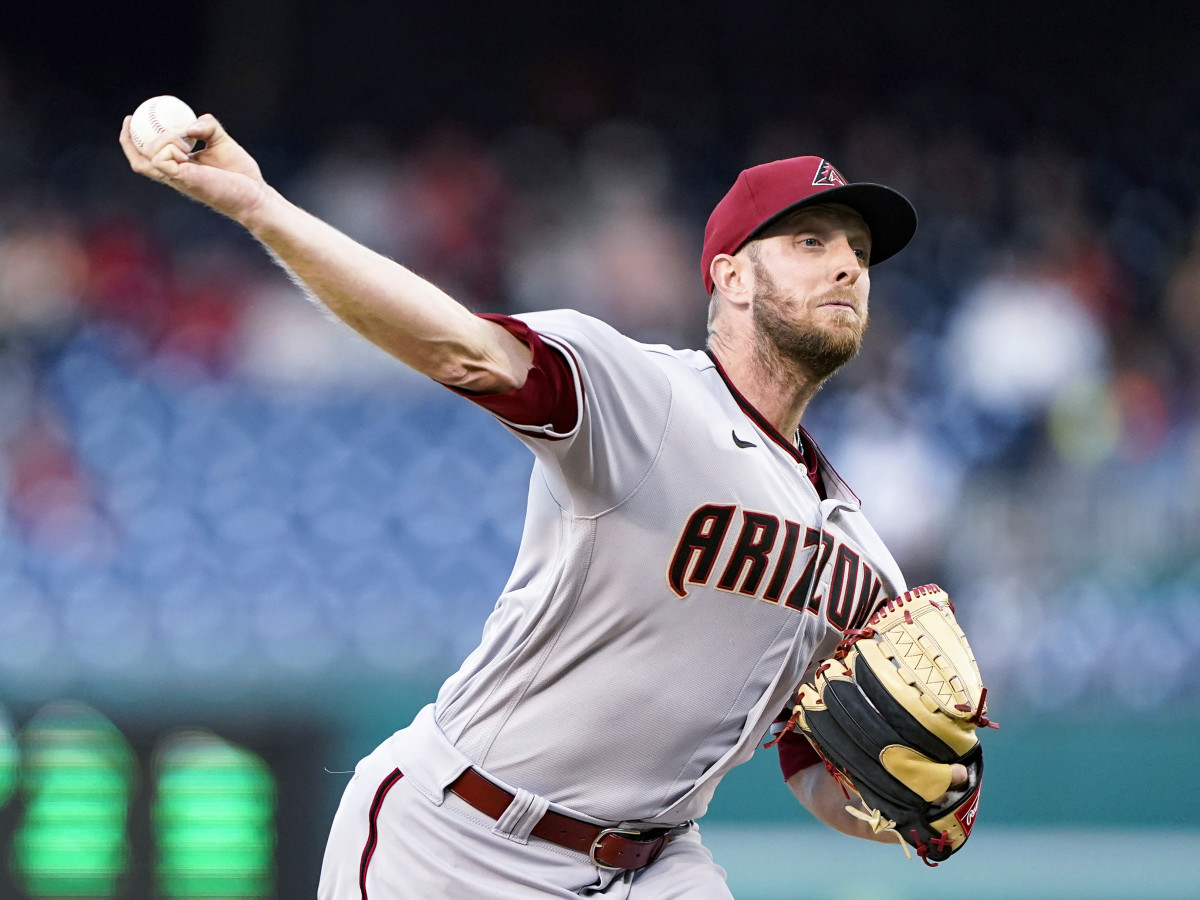
21. Arizona Diamondbacks (LW: 24)
I have to shout out Arizona’s entire rotation here as the biggest surprise, as D-Backs starters rank second in the majors with a 2.21 ERA. From Madison Bumgarner’s turning back the clock (despite ominous peripheral stats) to Zac Gallen’s bouncing back in full force and Merrill Kelly’s breakout (MLB-high 1.9 bWAR among pitchers), the rotation has helped push the Snakes above .500. Unfortunately for them, they’re in the NL West, so they’re still in last place in the division.
VERDUCCI: The Pitching Coach Behind the Diamondbacks’ Revival
20. Texas Rangers (LW: 23)
The Rangers were hoping they were paying $175 million for the 2019 and ’21 version of Marcus Semien, who finished third in MVP voting each of those years and set the single-season record for home runs by a second baseman last season. Instead, he’s been even worse than he was in ’20, when he cratered his value ahead of his first foray into free agency, and is still searching for his first home run as a Ranger. Maybe he’s just an odd-year type of guy.
19. Philadelphia Phillies (LW: 15)
No one has been wildly overperforming or disappointing in Philadelphia, but it’s been sad to see the Ranger Suárez train slow down a bit after he was one of the more unexpected breakout players of 2021. After last year’s 3.0-WAR campaign split between the bullpen and rotation, he’s a full-time starter this season and has seen his strikeout rate sink from 25.6% to 14%, while his ERA is up to 4.63 from last year’s microscopic 1.36 mark. He’s also already matched his ’21 total for home runs allowed with four. His stuff may miss more bats if it’s allowed to play up in the bullpen.
18. Miami Marlins (LW: 14)
Pablo López, April’s NL Pitcher of the Month, helped Miami snap a six-game losing streak Saturday by shutting out the Padres for eight innings, marking his fourth scoreless start in six outings. The 26-year-old ranks second in the majors with a 1.00 ERA. He sure looks like the real deal.
Pablo López, Sick Changeups. 👌 pic.twitter.com/S5JVOEu3ro
— Rob Friedman (@PitchingNinja) May 8, 2022
17. Seattle Mariners (LW: 10)
After grading out as a league-average offensive player for his first five seasons—only one of which included more than 100 games played—J.P. Crawford has unlocked a new level in his age-28 season, ranking seventh in OPS (.981). He trails only Wander Franco among shortstops in fWAR (1.4), putting him in contention to start the All-Star Game if the Mariners can hang around in the AL West. This past week was a rough one in that regard, as Seattle was swept by Houston before losing three of four to Franco’s Rays.
16. Colorado Rockies (LW: 17)
C.J. Cron is the latest slugger in a long line of Rockies to figure out how to bash in the high altitude of Coors Field. If he hit as well everywhere as he does in Denver, he’d be the closest comparison we have to Barry Bonds at the plate. As it is, his home OPS is nearly 500 points higher than his road OPS, but he still leads the NL in both home runs (nine) and slugging percentage (.651) and leads all first baseman in fWAR (1.5).
15. Atlanta Braves (LW: 16)
Former No. 5 pick Kyle Wright seemingly has put it all together in his age-26 season after mostly struggling during his first few stints in the majors. A near-full season at Triple A last year seems to have done wonders. The Vanderbilt product ranks in the top 10 in strikeout rate (30.6%), ERA (1.74) and FIP (2.07). He’s passing both the eye test and the sabermetric evaluations with flying colors; just check out his Statcast grid, where he ranks in the upper half of all 14 statistics.
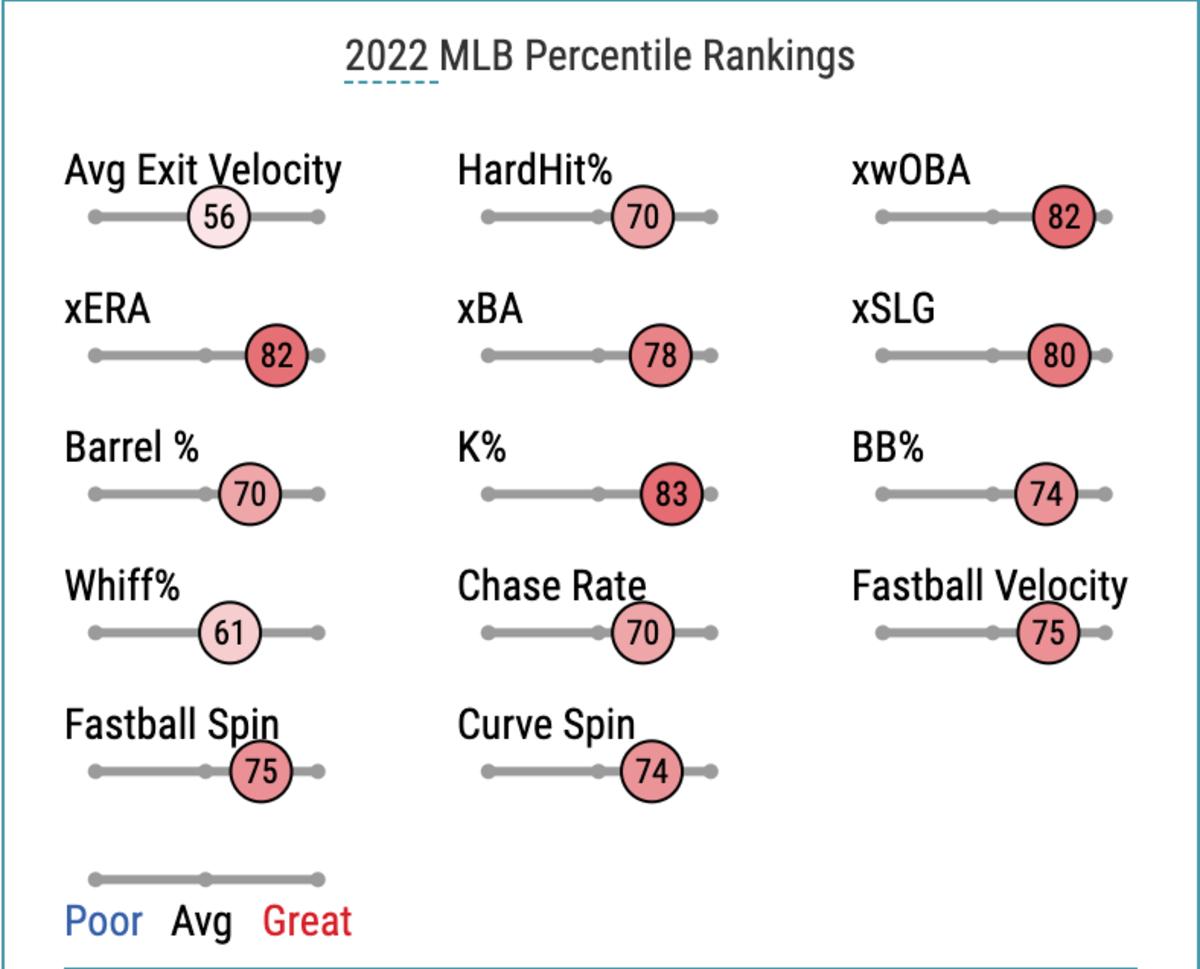
14. Cleveland Guardians (LW: 20)
Cleveland’s lineup hasn’t been up to snuff in recent years, but Owen Miller’s second-year breakout has helped change that to transform the Guardians to a top-five offense by wRC+ (116). A short stint on the COVID-19 list is currently preventing him from qualifying for the league leaderboards, but if he did, he’d rank fourth in OPS (1.043), directly above teammate José Ramírez. He’s looking like the crown jewel of the package Cleveland got in return from San Diego in the Mike Clevinger trade.
13. Chicago White Sox (LW: 19)
A six-game winning streak has the White Sox right back in the thick of the AL Central race. Michael Kopech somehow has yet to earn a win this season despite holding a 1.17 ERA after five starts. His first full season in the rotation has gone so well that he was angry after throwing four shutout innings against the Cubs in his last start. He’s not striking out nearly as many hitters as he did out of the bullpen last year, but he’s also yet to give up a home run in 23 innings. The next step for Kopech, who was acquired from Boston in the Chris Sale trade in December 2016, is learning how to provide more length in his outings.
12. Minnesota Twins (LW: 12)
The Rays rarely lose trades, but they may have made a mistake by including Joe Ryan in last summer’s Nelson Cruz rental agreement. Ryan has proven highly adept at limiting baserunners during his two seasons in the majors. This year, the only pitchers with a lower WHIP than his 0.831 are Justin Verlander, Zac Gallen, Clayton Kershaw, Corbin Burnes and Carlos Rodón.
11. Toronto Blue Jays (LW: 5)
The Blue Jays gave up a steep price to acquire José Berríos from Minnesota last summer, and this season he has not looked to be worth the cost. Opposing hitters are batting over .301 against him, and his 1.64 WHIP is the third worst in MLB. His strikeout rate has plummeted while his walk and home run rates have shot up. It all combines for a very ugly set of Statcast sliders.
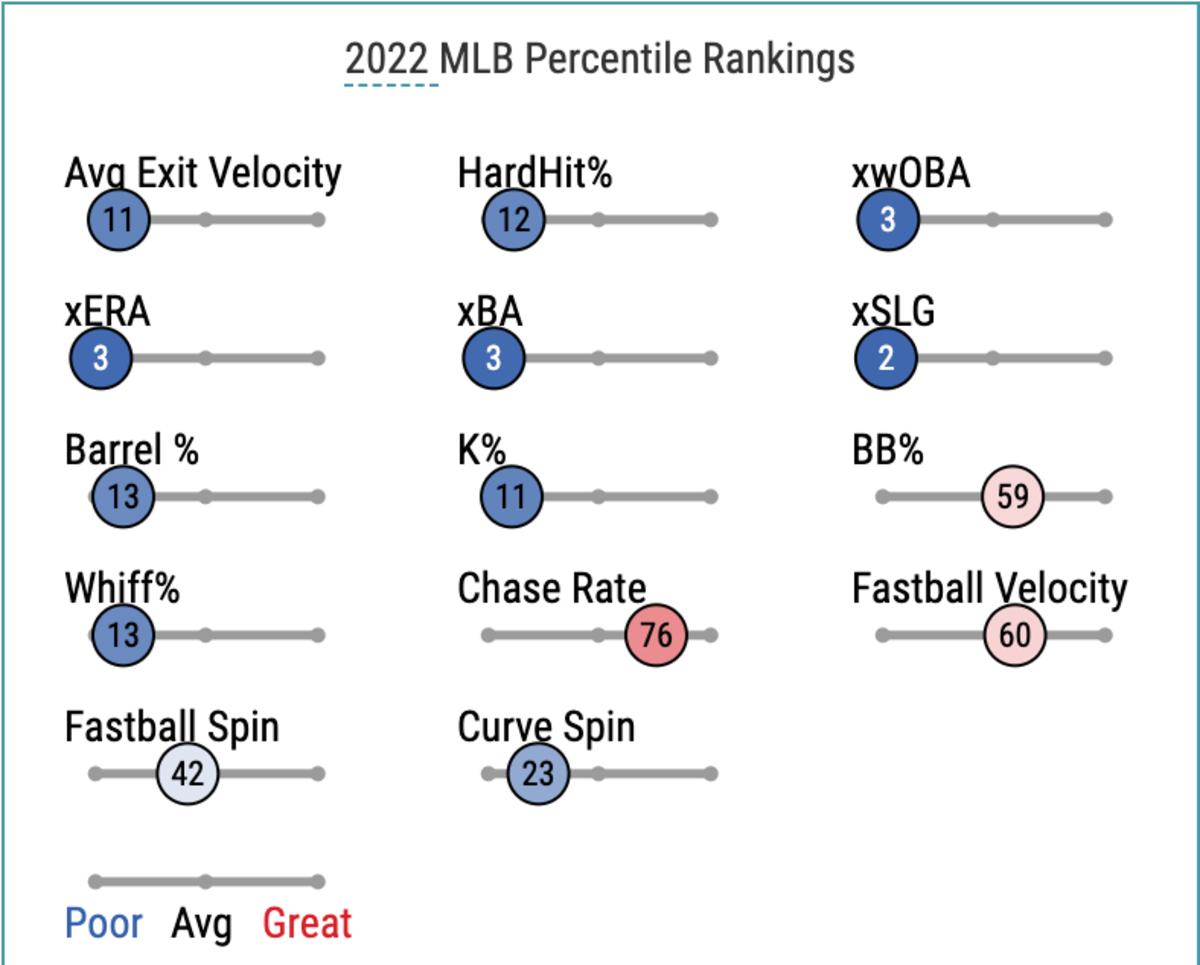
10. St. Louis Cardinals (LW: 11)
Ryan Helsley is one of just two relievers highlighted in this article because most relievers haven’t accumulated enough innings to have relevant statistics at this point. But what he’s done defies logic. By racking up 20 strikeouts in 10 innings with zero walks and just one hit allowed, Helsley has recorded a -0.93 FIP. Before seeing that, I did not realize it was possible to have a negative FIP, a statistic based on how many runs a pitcher should have allowed with the randomness of fielding removed from the equation. He could take over the closer’s job in St. Louis soon.
9. Houston Astros (LW: 13)
Carlos who? Jeremy Peña has been a terrific replacement for the departed Carlos Correa at shortstop, leading the Astros with six home runs and is tied for second among shortstops in fWAR (1.4).
8. San Francisco Giants (LW: 4)
After posting the best offensive season of his career last year in what seemed to be the beginning of a late-stage renaissance, Brandon Crawford has badly regressed. The 35-year-old also had a rookie moment on the basepaths Friday. At least he’s still an ace with the glove.
Elite baserunning from Brandon Crawford pic.twitter.com/WQKB4hqDPq
— Runners Getting Thrown Out (@tootblans) May 7, 2022
7. Los Angeles Angels (LW: 7)
If we had told you an Angels outfielder would be leading the majors in OPS a month into the season, you probably would’ve guessed it’d be Mike Trout or that Shohei Ohtani had taken to playing the field when he wasn’t pitching. Nope, it’s Taylor Ward, who also leads all outfielders with 1.9 fWAR. (Trout isn’t far behind him in either category, for the record.)
6. Tampa Bay Rays (LW: 9)
Lefty Jalen Beeks, 28, looks to be the leading candidate for this year’s Rays reliever who comes out of nowhere to make a run at an All-Star appearance. Beeks, who was traded by Boston to Tampa Bay in July 2018 for Nathan Eovaldi, throws his 90-mph “changeup” slightly more than his mid-90s fastball to great effect. He ranks in the 95th percentile of whiff rate and the 90th percentile of strikeout rate and has yet to give up a run in 10 ⅔ innings.
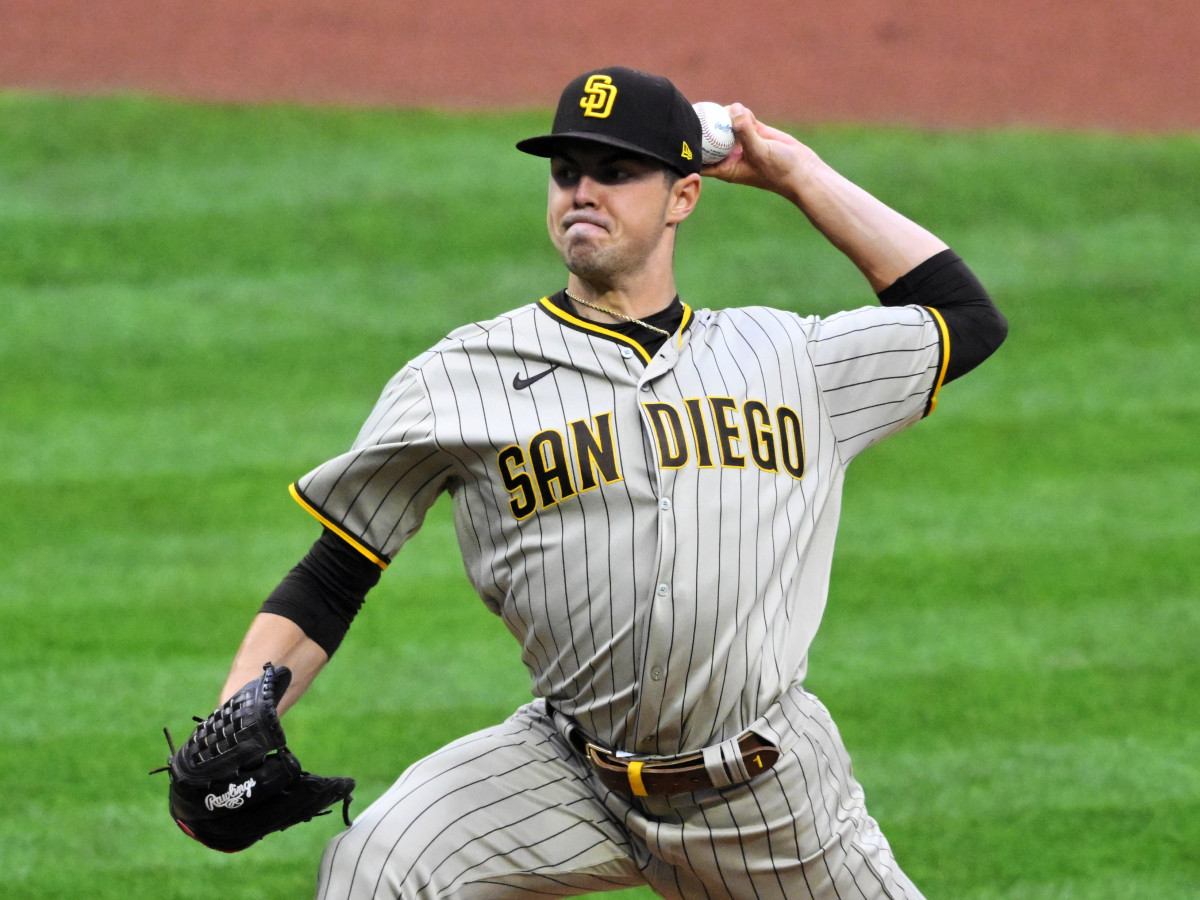
5. San Diego Padres (LW: 6)
Mackenzie Gore was the No. 3 pick of the 2017 draft and was seen as the sport’s top pitching prospect heading into 2020, so perhaps it shouldn’t come as a surprise that he’s been dealing in the first four starts of his MLB career. But he lost a year of game action due to the pandemic and then struggled enough with mechanical issues last season to the point he wasn’t called up when San Diego was desperately thin in the rotation. Those seem to be behind him now, though two of his four starts have come against the Reds, so let’s not put him at the top of the Rookie of the Year race quite yet.
4. Milwaukee Brewers (LW: 8)
With only one of Milwaukee’s Big Three rotation arms performing up to their lofty 2021 standards so far, the emergence of Eric Lauer has been a godsend for the Crew. The lefty’s 36.2% strikeout rate ranks third among qualified pitchers and is a massive improvement after he’d hovered around 20% for his previous four seasons.
3. New York Mets (LW: 2)
For all of the talented hitters on Mets’ record payroll, it’s Jeff McNeil who’s emerged as the team’s OPS leader thus far. The 30-year-old, who’s still three years away from free agency, also ranks fourth in fWAR (1.4) among all outfielders, behind only Taylor Ward, Mike Trout and Aaron Judge.
2. New York Yankees (LW: 3)
Four Yankees starters have an ERA lower than 3.00, the lowest of which belongs to Nestor Cortes. Nasty Nestor’s fastball velocity ranks in the mere fourth percentile of pitchers. He’s figured out a way to make it work, though, ramping up his strikeout rate to 32%, higher than that of Gerrit Cole (29.6%). Who needs overpowering stuff when you’ve got a magnificent mustache?
1. Los Angeles Dodgers (LW: 1)
Tyler Anderson had pitched for four teams in the last three seasons before joining the Dodgers on a one-year, $8 million contract this offseason. In a rotation with an MLB-best 1.83 ERA, he’s actually been the least impressive of the six pitchers to make a start … and has logged a still-stellar 2.78 ERA. The underlying statistics look fantastic, too, which is made even more impressive by the fact that he’s one of the slowest throwers in the league. The 32-year-old seems like he’ll count as another success story on the team’s long list of reclamation projects under Andrew Friedman.
More MLB Coverage:
• The Pitching Coach Behind the Diamondbacks’ Revival
• The Day ‘Shotime’ Came to Fenway Park
• How Concerned Should We Be About These Five Sluggish Starts?
• Five-Tool Newsletter: Christian Yelich Is Back in MVP Form
• The Sweeper Is MLB’s Trendiest Pitch, But It’s Not Entirely New
